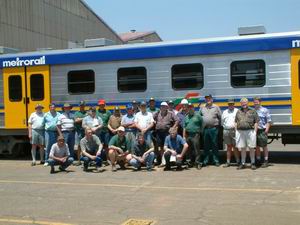 |
This is
a photo of a bunch of the train fans from the Pretoria Model Train club
on a trip to the Koedoespoort work shop in October 2002. The shine
coach behind us, is the class 10M3 metro coaches used in Cape Town.
At the time of the photo only 2 coaches have been delivered to the Metro
service, and a large number was ready and waiting to be delivered. |
 |
The day
was scorching, and we took a breather inside one of the new 10M3 METRO
coaches. Photo taken at Koedoespoort, Oct. 2002 |
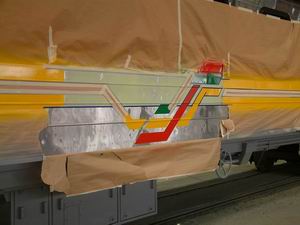 |
The whole
coach is taped and masked, before the nice striping is painted onto the
side of a 10M3 coach. The whole coach needs to be masked, because
they nice stainless surface must not get spoilt by over spray. The
people from METRO prefer to give all those budding graffiti artists a nice
clean canvas to paint on... Photo taken at Koedoespoort, Oct. 2002 |
 |
This is
a old steam crane used by the SAR/SAS of old. It was built by Sheldon
& co of England. Photo taken at Koedoespoort, Oct. 2002 |
 |
Another
view of the crane. Photo taken at Koedoespoort, Oct. 2002. |
 |
This is
what I suppose is the manufacturer's plate and operating instructions.
As can be seen from this plate, the crane was built in England in 1937.
Photo taken at Koedoespoort, Oct. 2002. |
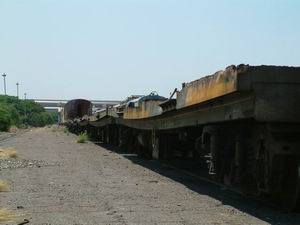 |
Not all
5M Metro wagons are in a good enough condition to be rebuilt or reconditioned.
If a coach is too badly damaged, the top is sold as scrap. What is
left can be seen here. This will eventually be upgraded and become
a 10M3 with shiny stainless steel sides. Photo taken at Koedoespoort,
Oct. 2002. |
 |
This photo
gives one an idea of just how big the wheels of our current locos are.
The wheel at the bottom left, is a diesel loco wheel. Center is a
class 11E wheel, and the set on the right hand side, belongs to a metro
motor unit. Photo taken at Koedoespoort, Oct. 2002. |
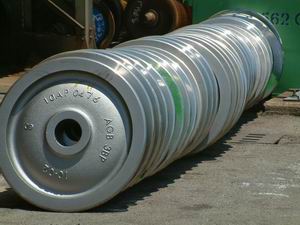 |
Unlike
the case is with railroad modeling, real train wheels are not supplied
in sets ready to be fitted. Here a row of brand new wheels, cast
on solid steel can be seen. Photo taken at Koedoespoort, Oct. 2002. |
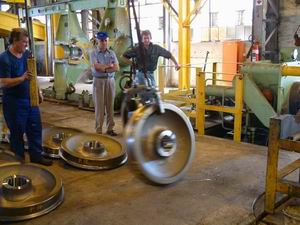 |
The wheels
are shaped (profiled) and marked. They are then lined up to be fitted
to an axle. Photo Koedoespoort, Oct. 2002. |
 |
The axles
are also turned to have the exact diameter where the wheels are to be fitted.
The axle is turned to fit only one specific wheel. Both the wheels
and the axle is marked to be identified as a set by the fitting team.
Here the axle to match the 2 wheels in the previous photo, it selected.
Photo taken at Koedoespoort, Oct. 2002. |
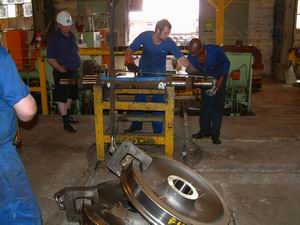 |
Now the
center point of the axle is determined to ensure that no one wheel is pushed
on too much or too little. Photo taken at Koedoespoort, Oct. 2002. |
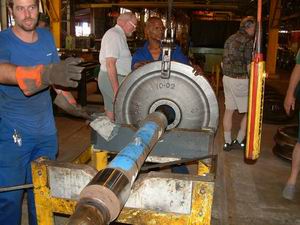 |
The wheels
are now loosely fitted to the axle, before a machine will press fit the
wheels over the axle to exactly the right position. by the way, the
hole in the wheel has a circumference of approx. 1mm less than that of
the outer diameter of the axle. This results in a pretty tight fit.
Photo taken at Koedoespoort, Oct. 2002. |
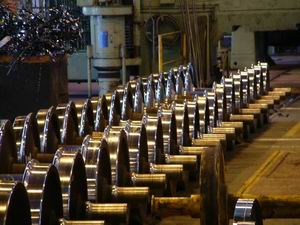 |
When both
wheels are fitted to the axle, the wheels are rolled into this nice queue
to be fitted to the METRO units. Photo taken at Koedoespoort, Oct.
2002. |
 |
Not all
train wheels are constructed from only wheels and axles. Some wheels
use a 'rim' and a 'tyre'. The basic shape of the tyre is cast from
steel. Now the tyre has to be machined to get the right inside and
outside profiles. This lathe is turning the inside profile of the
tyre. Photo taken at Koedoespoort, Oct. 2002. |
 |
This is
just a little closer look at the same turning process. Photo taken
at Koedoespoort, Oct. 2002. |
 |
As can
be imagined, cutting steel at any rate generates a lot of heat. Turning
the basic inside profile took only a couple of minutes. The amount of heat
generated can be seen here as clouds of smoke and steam from the coolant
(the jet of white liquid). Photo taken at Koedoespoort, Oct. 2002. |
 |
This is
a closer look at the Gibson ring (Thanx to Les Kenward for that reminder).
The ring is used to keep the tyre on the wheel. Photo taken at Koedoespoort,
Oct. 2002. |
 |
Here 2
wheels can be seen stacked on top of each other. Right at the top
a groove is visible. The spring loaded Gibson ring is fitted in the
groove after a rim is put inside the wheel. The little edge above
the ring is then pressed down to effectively lock the ring in place, and
keep the wheel and rim from coming apart. Photo taken at Koedoespoort,
Oct. 2002. |
 |
Once the
ring is in place, a little spacer (seen lying on the work surface inside
the wheels) is fitted in the gap in the ring and welded in place.
Photo taken at Koedoespoort, Oct. 2002. |
 |
This is a rail inspection car. I have no information
about it. The photo was taken at the Klerksdorp station, Dec. 2002. |




















